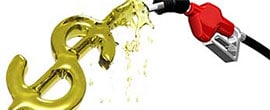The more fuel your car uses, the more it impacts on the environment.
Following these 10 tips will help to reduce your fuel costs, air pollution and greenhouse gases.
-
Accelerate gently
Avoid high revs. Automatic transmissions will shift up more quickly and smoothly if you ease back slightly on the accelerator once the car is moving. To maintain low revs in manual cars, you should change up through the gears as soon as the car is comfortable with the next higher gear. Don’t rev the car unnecessarily.
-
Flow smoothly with the traffic
Be aware of traffic conditions ahead so you can anticipate the next stop and avoid unnecessary acceleration and braking. Driving a good distance from the car in front means you can see what is happening ahead and you don’t have to brake every time they do. As well as saving fuel, smoother driving is safer.
-
Avoid excessive speeds
High speeds result in high fuel consumption. Where it is safe to do so, cruising slightly below the speed limit will save you fuel. Traveling at 100km/h instead of 110km/h can reduce fuel consumption by 10%.
-
Avoid lengthy idling
Turn off your engine when stopped for an extended period and not in traffic. By having the engine switched off, even for a short period, you will save more fuel than is lost from the burst of fuel involved in restarting the engine. The net increased wear and tear from this practice is negligible. Most cars do not need to be ‘warmed up’ prior to driving off. After starting the engine, move off as soon as it is safe to.
-
Avoid congested traffic and driving more than necessary
The best way to reduce fuel consumption is to reduce the amount of driving you do. Consider combining trips, car pooling or using other modes of transport. Replacing short trips with walking or cycling is particularly good as cars are least efficient and most polluting when the engine is cold at the start of trips. Stop-start driving is very fuel inefficient, so plan your travel to avoid driving in congested traffic.
-
Keep your car well maintained
If your vehicle is running correctly, it will use less fuel and be more reliable. Have it serviced in accordance with the owner’s manual (usually every six months or 10,000km, whichever comes first) and regularly check oil, coolant and other fluid levels. Watch out for any changes in the way the car handles or sounds as these changes could indicate a problem that needs fixing. A smoky exhaust means the engine needs checking. Keep a record of your fuel consumption as increasing fuel consumption can also be a sign of a problem.
-
Keep tyres properly inflated
Inflate your vehicle’s tyres to the higher end of the manufacturer’s recommended range of tyre pressures and make sure your wheels are properly aligned. Looking after your tyres will not only reduce your fuel consumption it will also extend tyre life and improve handling.
-
Use the air conditioner sparingly
Air conditioners can increase fuel consumption by between 5 and 10%, particularly on very hot days. However, at higher speeds, use of air conditioning is better for fuel consumption than an open window. Leaking air conditioner gases can contribute to the greenhouse problem. To keep the air conditioner operating properly and avoid leaks, you may need to use it regularly throughout the year for a short period as well as having it regularly serviced. Check the owner’s manual.
-
Minimise wind resistance
Remove roof racks and other attachments when they are not being used. Additional parts on the exterior of a vehicle such as roof racks or sun visors, or having the window open when traveling at higher speeds, increases wind resistance and fuel consumption.
-
Remove unnecessary weight from the car
Remove unnecessary items from the boot. The more weight a vehicle carries the more fuel it uses, particularly in urban driving.
Original story: RACV




